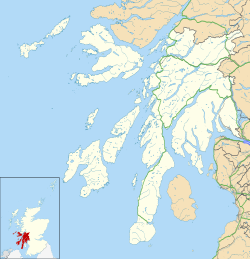History
Duart Castle was probably built by Clan MacDougall in the 13th century, and appears to have come into the hands of Clan MacLean in the following century. [3]
In 1350, Lachlan Lubanach Maclean of Duart, the 5th Clan Chief, married Mary Macdonald, daughter of John of Islay, Lord of the Isles, and Duart was part of her dowry. [4] John of Islay's son, Donald Macdonald, Lord of the Isles, confirmed the castle by charter to the Macleans in 1390.
In 1647, Duart Castle was attacked and laid siege to by the Argyll government troops of Clan Campbell, but they were defeated and driven off by the Royalist troops of Clan MacLean.
In September 1653, a Cromwellian task force of six ships anchored off the castle, but the Macleans had already fled to Tiree. A storm blew up on the 13 September and three ships were lost, including Swan. To the north of the castle is a Historic Marine Protected Area within which lie the remains of a wrecked 17th century warship, believed to be the Swan. [5]
In 1678, the 9th Earl of Argyll, Chief of Clan Campbell and son of the late Marquess of Argyll, successfully invaded the Clan MacLean lands on the Isle of Mull and Sir John Maclean, 4th Baronet, fled the castle and withdrew to Cairnbulg Castle, and afterward to Kintail under the protection of the 3rd Earl of Seaforth. [6]
In 1691, Duart Castle was surrendered by Sir John Maclean, 4th Baronet, to the 10th Earl of Argyll (who was later created, in 1701, the 1st Duke of Argyll). [1] The Campbell clan partially demolished the castle, and the stones from the walls were scattered. The 5th Laird of Torloisk used some of the stones to build a cottage for his family close to the site of the castle. [7]
By 1751, the remains of the castle were abandoned. [8]
Descendants of the 1st Duke of Argyll sold the castle in 1801, to MacQuarrie, who then sold it to Carter-Campbell of Possil who kept it as a ruin within the grounds of his own estate to the north, Torosay Castle. He later sold his Torosay Estate, which now included the ruins of Castle Duart, to A. C. Guthrie in 1865. On 11 September 1911, the ruin was separated from the rest of the Torosay Estate and was bought by Sir Fitzroy Donald Maclean, the 26th Chief of the Clan MacLean, and restored. [1] [9] [10]
By 2012, additional restorations were required and a fund was set up to accept donations for this purpose. Phase 7 of the project was underway in 2020. [11]
This page is based on this
Wikipedia article Text is available under the
CC BY-SA 4.0 license; additional terms may apply.
Images, videos and audio are available under their respective licenses.





